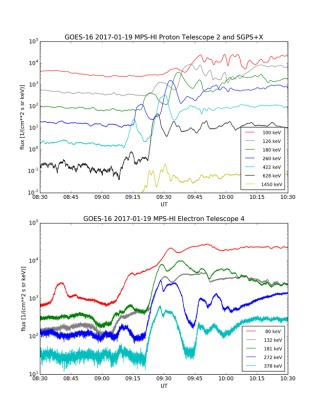|
|
In The News


|
ATC
GOES-R SEISS Sensor Suite On-Orbit And Providing High-Quality Data
January 23, 2017
NOAA's GOES-R satellite launched from Kennedy Space Center on November 19, 2016, carrying
the latest generation of terrestrial and space-weather instrumentation. Among the payloads
is the Space Environment In-Situ Suite (SEISS), developed by Assurance Technology Corporation
(ATC), and its subcontractor, the University of New Hampshire. GOES-R achieved geostationary
orbit on November 23, 2016, and was renamed GOES-16.
ATC activated the SEISS Data Processing Unit (DPU) on 21 December 2016, and began its
successful checkout procedure. The SEISS team activated on the five SEISS sensors (MPS-LO,
MPS-HI, SGPS+X, SGPS-X, and EHIS) on 8 January 2017, and began their successful check-out
and cross calibration.
The Magnetospheric Particle Sensor – Low Energy (MPS-LO) measures the flux of electrons and
ion in the 30 eV to 30 keV energy range – those particles responsible for spacecraft charging.
The MPS-LO sensor provides new capability for the GOES-series spacecraft.
The Magnetospheric Particle Sensor – High Energy (MPS-HI) and the two Solar and Galactic
Proton Sensors (SPGS+X and SPGS-X) provide extended energy ranges, better energy resolution
and better temporal resolution than the GOES-series heritage instruments.
| |

|
The Energetic Heavy Ion Sensor (EHIS) measures the flux and elemental charge of protons,
alpha particles and heavy ions originating from the sun or from outside the solar system.
EHIS also provides new capability for the GOES-series spacecraft.
The DPU and all the SEISS sensors are operating and returning high-quality data. ATC
continues to support the on-going data validation and cross-calibration activities during
the six month Post Launch Test (PLT) period.
This plot of SEISS data shows injections of protons and electrons observed by the Magnetospheric
Particle Sensors MPS-HI and Solar and Galactic Proton Sensor (SGPS) on January 19, 2017. The
fluxes shown are from the MPS-HI telescopes that look radially outward from the Earth, and from
the lowest-energy channel observed by the eastward-looking SGPS. These data exemplify the improved
energy and temporal resolution of SEISS compared to the heritage GOES instruments, and are
revealing detail in the geomagnetic environment only hinted at in the heritage data.
|
|
|
|
|
© Assurance Technology Corporation. All Rights Reserved
|
|
|
|





